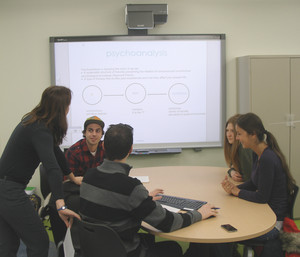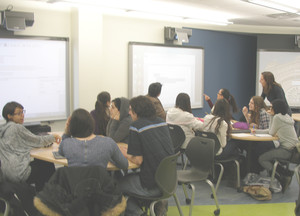Putting Our Egos on the Shelf
Learning About Active Learning
I wanted to try a different approach to teaching, and at a ped day at my college, I got exposed to active learning. Having just been given a new complementary course to teach, I thought that it would be a great place to start applying active learning concepts like “think-pair-share”, “pyramids” and “peer teaching”. These active learning techniques were all implemented without technological support. We had pens and papers, markers and sometimes posters. Physically groups of students would move to different areas in the classroom and awkwardly work around big linear tables. The structure and function of this room were not very conducive to student collaboration.

Kathy and a student team working on a problem in the active learning classroom
Then, I got an opportunity to get involved in an active learning classroom. Chris Whittaker, the brain behind this revolutionary classroom, was looking for teachers who wanted to take active learning to another level by building an Active Learning Classroom in Dawson. I got on board right away.
Using the Active Learning Classroom for Complementary Classes
The difference is unbelievable because as much as you try to implement active learning in a traditional classroom, the structure of the room itself, with linear desks, creates logistics to overcome. In the active learning classroom, the tables, which resemble petals of a leaf, promote interaction. Everyone can see everyone at the desks, and our chairs are on wheels, which is pretty fun too. I am not the center of the classroom physically or pedagogically.
To me, and to one of my students who wrote it in one of his reflections, there’s no real front of the room. This is the idea! It doesn’t matter where I am because the focus is around the tables. and it spans out to the SmartBoards. Just the functionality of having a structure that supported what I was doing was amazing.

There is no front of the room!
Integrating the Smartboard into Active Learning
Well you can have a SmartBoard, and you can do a lot of fun stuff with a SmartBoard, but that doesn’t mean that you’re doing active learning. You can do active learning and do lots of great stuff, but the ability to throw that stuff on the Smartboard, demonstrating your knowledge to the rest of your classmates is better than just using a standard computer. You can take a SMART pen, brainstorm, draw diagrams, create a concept map… and then you get to present to everybody in the class. That’s got to be better than – Here’s my piece of paper, Miss, and here’s what my group came up with on the idea of critical thinking.
Adjusting to the New Paradigm of Students Learning Independently
Technologically, the active learning classroom not been a big leap for me at all because I’ve always tried to be on the cutting edge of technology. I was a big proponent of getting SmartBoards in my department. Technology has never been an issue, and the idea of having seven SmartBoards in the same classroom is not intimidating to me, but the paradigm shift is another story. I think the biggest challenge is the loss of predictability.

The focus is no longer on the teacher
I work really hard before I get to class because I have to be prepared, yet I don’t know what to expect. Because the focus is no longer on the teacher, I don’t know what’s going to happen. I have to sit back, I have to be less involved, and I have to let my students… learn, exchange, collaborate. That’s the hard part. I have to wait a second because it’s not all about me; it’s about them, and how to get the most out of them. Students have eight people at their table as resources instead of just one person at the front of the room. As teachers, we just have to put our egos on the shelf and become the facilitator not the focus.
We’re teaching critical thinking; teaching students to have a look at the world around them and have an involvement in it because they’ve become a member of a community.
Beyond critical thinking, we’re teaching respect. My students created this grid about what it means to be part of this class and what collaboration is. It’s not just talking all the time; it’s about listening. It’s not the person who knows it all; it’s about people feeling comfortable to express themselves. It’s about coming to class prepared; it’s about coming to class on time. Students came up with these things because they’re responsible to a group, not just to a teacher anymore. A community of students does more than just learn; students share.
As a teacher, I’m contributing to students’ self-esteem because I’m giving them the opportunity to say things in class, to share their ideas, and to be listened to in a safe and respectful environment.

